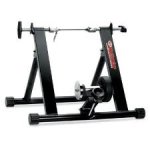At 8mph, my 9c hub with regen on charges about 50-70watts. That's a nice low current charge rate that would add up nicely after a couple hours.
My idea is to get a bike trainer (stand that securely holds rear wheel off ground), and secure it to a wind generator, and use a simple wheel-on-wheel friction transmission. No wires, no gears, no controller, nothing but a wind turbine driving my rear wheel at 6-12mph.
Some problems - what size turbine will I need to generate the required ~120watts at the turbine shaft to spin the ebike wheel at the needed speed? Maybe it will require turbine blades that would put the shaft too high above the ground/rear tire. A solution could be a vertical turbine and laying the bike horizontal.
Tire wear? Perhaps over time. But at these low power levels, there won't be much friction needed to maintain contact. Again, I'm aiming for around 60watts regen on my CA. I find 'used' tires for cheap anyway, so not a big deal.
Controller wear? I would think it wouldn't add up compared to normal ebiking power draws.
Strong points: never will overcharge my battery since regen doesn't work above 55v on my setting. Simple, low cost. Uses what I already have (DD wheel, controller).
Thoughts?
My idea is to get a bike trainer (stand that securely holds rear wheel off ground), and secure it to a wind generator, and use a simple wheel-on-wheel friction transmission. No wires, no gears, no controller, nothing but a wind turbine driving my rear wheel at 6-12mph.
Some problems - what size turbine will I need to generate the required ~120watts at the turbine shaft to spin the ebike wheel at the needed speed? Maybe it will require turbine blades that would put the shaft too high above the ground/rear tire. A solution could be a vertical turbine and laying the bike horizontal.
Tire wear? Perhaps over time. But at these low power levels, there won't be much friction needed to maintain contact. Again, I'm aiming for around 60watts regen on my CA. I find 'used' tires for cheap anyway, so not a big deal.
Controller wear? I would think it wouldn't add up compared to normal ebiking power draws.
Strong points: never will overcharge my battery since regen doesn't work above 55v on my setting. Simple, low cost. Uses what I already have (DD wheel, controller).
Thoughts?


